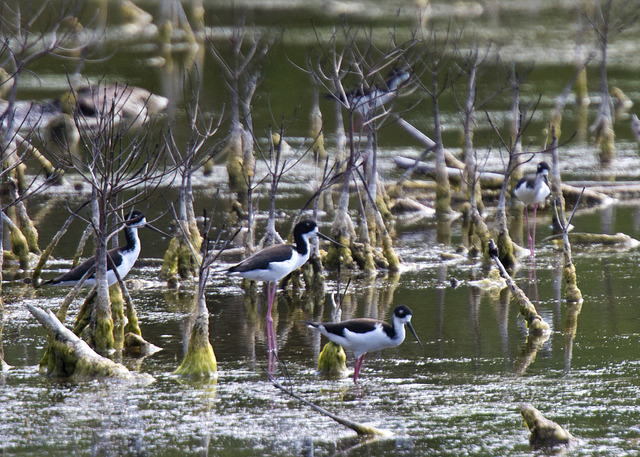By WILLIAM COLE ADVERTISING By WILLIAM COLE Honolulu Star-Advertiser HONOLULU — The Navy said it spent $1.35 million to clean up munitions-related items from Ordy Pond, a 10,000-year-old limestone sinkhole on the old Barbers Point Naval Air Station that’s helped
By WILLIAM COLE
Honolulu Star-Advertiser
HONOLULU — The Navy said it spent $1.35 million to clean up munitions-related items from Ordy Pond, a 10,000-year-old limestone sinkhole on the old Barbers Point Naval Air Station that’s helped point to when Polynesians first colonized Oahu.
After the Navy used heavy equipment to remove mangroves choking the shoreline, water birds including the endangered Hawaiian stilt have been spotted at the 1.2-acre brackish-water pond, which is about 18 to 19 feet deep with silt and sediment below that.
The state has been trying to figure out what to do with it and two other parcels — one with a separate unique feature — that the Navy wants to turn over by the end of fiscal 2016 as part of the 1999 closure of Barbers Point.
The way ahead may be clearer for Ordy Pond. The Hawaii Community Development Authority, the state agency that will receive the parcels, said it intends to fence off the sinkhole for safety and allow continued research and access by organizations such as the University of Hawaii.
“Ordy Pond to me is a very unique parcel, and its value really is for research,” said Anthony Ching, HCDA’s executive director.
A 2014 study published in American Antiquity by J. Stephen Athens, Timothy M. Rieth and Thomas S. Dye said Ordy Pond “has some almost unique characteristics” in that coring samples can be used to obtain high-resolution chronological and environmental information dating to and beyond the earliest human habitation on Oahu. Using plant remains analysis, the authors concluded colonization may have occurred between A.D. 936 and 1133.
UH described Ordy Pond’s 44 feet of aquatic sediment as the “best-preserved, continuous, high-resolution Holocene sedimentary record in the Hawaiian Islands, and probably in the central Pacific.”
The northern and southern trap and skeet ranges — both of which were littered with lead and later cleaned up — are the two other parcels the Navy wants to convey to HCDA as part of a more than 200-acre deal.
Ironically, the northern range has the world’s only native growing population of Chamaesyce skottsbergii var. kalaeloana, otherwise known as the endangered Ewa Plains akoko, according to the U.S. Fish and Wildlife Service.
Both sites were identified as having Hawaiian habitation features.
HCDA wants to put in solar panels on parts of both ranges — which would help offset an estimated annual $100,000 to $300,000 akoko preservation effort, Ching said.
Slow progress toward the turnover has come with the end of the munitions cleanup at Ordy Pond. CAPE Environmental Management Inc., the contractor on the project, retrieved nearly 486 munitions-related items in and around the pond that got its name from a longer moniker, “Ordnance Pond.”
The list includes 94 marine markers and parachute, signal and illumination flares.
A total of 236 JAU-22/B impulse cartridges used to eject sonobuoy acoustic devices from aircraft, possibly P-3 Orion sub hunters, were pulled out of Ordy Pond.
Fourteen Mk-76 25-pound practice bombs with “spotting” charges to mark the impact were retrieved, along with seven 100-pound practice bombs with spotting charges. A handful of blank and live-round small arms ammunition also was collected.
The items were destroyed at a nearby site with controlled blasts, the Navy said.
According to a 2007 Navy study, Ordy Pond repeatedly was used for the disposal of ordnance-related material from the late 1960s to the late 1970s.
Why it was dumped into the pond is unclear, but some old munitions magazines are nearby.
“Back in the ’60s and stuff, there weren’t any laws, so I guess things happened. Not the best,” said Eric Shigaki, remedial project manager for the Ordy Pond project.
In 2005 in Florida, more than a dozen JAU-22/B impulse cartridges were discovered in a stormwater ditch at the former Naval Air Station Cecil Field. Discarded signal cartridges and practice bombs also were located.
The Kapolei Neighborhood Board in 2013 asked the Navy why UH was never advised of a “dangerous” ordnance situation during past sediment study at Ordy Pond.
The Navy responded that an initial assessment was done in 1981, followed by a remedial investigation in 1994. Only limited ordnance was found, it said, and at the time of a UH sampling in 1998, the Navy believed the pond was cleared.
When the base closed, the Navy took another look and found a lot more munitions-related items, it said.
Denise Emsley, a spokeswoman for Naval Facilities Engineering Command Hawaii, said the survey for munitions at Ordy Pond was completed as of October. Divers felt around in the silt at the bottom of the murky water to retrieve some of the items.
Contractor reports and another environmental study could take a year or more.
Fish and Wildlife and the HCDA have been at odds, meanwhile, over management of the akoko on the northern trap and skeet range, including how much land should be set aside for the endangered plant.(backslash)
“We’re still working on it. It’s still a work in progress,” said Aaron Nadig, a Fish and Wildlife biologist.
Ching said HCDA wants to offset the akoko management’s $100,000 to $300,000 annual cost, “so certain PV comes to mind because that’s a perfect area for it.” Both akoko and photovoltaics can coexist, Ching said.
“We’ve had some discussions with people, and so that would seem to be a very good pursuit,” he said.



